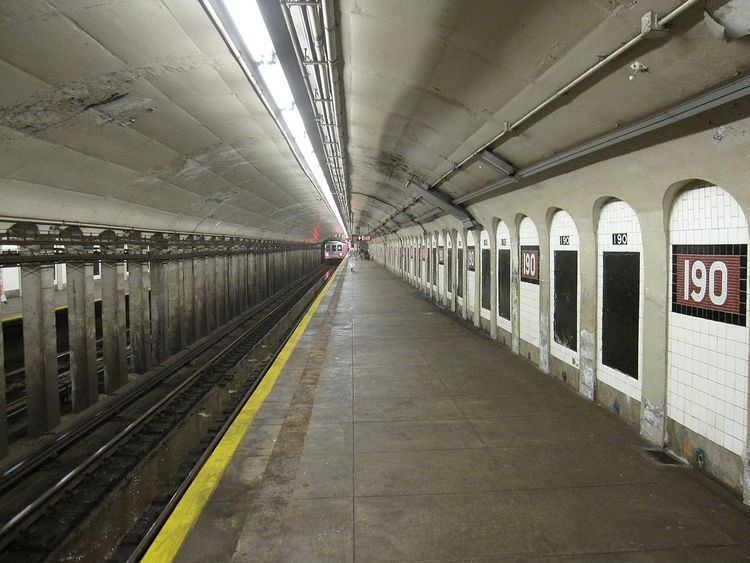Division B (IND) Services A (all times) Structure Underground Borough Manhattan Added to NRHP 30 March 2005 | Line IND Eighth Avenue Line Transit connections NYCT Bus: M4, M98 Depth 140 feet (43 m) Opened 10 September 1932 Tracks 2 | |
 | ||
Address Bennett Ave, New York, NY 10040, USA Locale Washington Heights, Hudson Heights, Manhattan Similar 181st Street, Inwood–207th Street, 175th Street, 135th Street, 155th Street | ||
190th Street (originally 190th Street – Overlook Terrace) is a station on the IND Eighth Avenue Line of the New York City Subway, served by the A train at all times. It is located on Fort Washington Avenue near its intersection with Cabrini Boulevard at Margaret Corbin Circle, about 3 blocks north of 190th Street.
Contents
The station is close to Fort Tryon Park and the Mother Cabrini Shrine in the Hudson Heights neighborhood of Manhattan's Washington Heights area. The Cloisters medieval art museum, a branch of the Metropolitan Museum of Art, is located in the park, about a 10-minute walk north from the station's Fort Washington Avenue exit. An additional exit through the side of the hill leads to Bennett Avenue and provides access to the Broadway Valley area of Washington Heights.
Station layout
The station has two tracks and two side platforms. It is the third-to-last station on the IND Eighth Avenue Line proceeding northbound. The station boasts platforms 660 feet (200 m) in length—a typical length of station platforms in the Independent Subway System—and 50 feet (15 m) in width. The station has a double-barrel, vaulted ceiling supported by an arcade in the center. Concrete retaining walls also side the station and fit into the structure. The 207th Street-bound platform contains an exit-only (one turnstile and one gate) ramp that bypasses fare control and leads to the passageway to the Bennett Avenue entrance.
Located 140 feet (43 m) below ground level, it is one of the deepest stations in the entire system by distance to ground level; it is even deeper than the 34th Street – Hudson Yards station, the deepest station in the system by elevation below sea level. (By comparison, 34th Street – Hudson Yards is only 110 feet (34 m) below the surface, which is about 15 to 20 feet (4.6 to 6.1 m) above sea level.) Despite the fact that this is an extremely deep station, however, the Bennett Avenue entrance is actually at a lower elevation than the platforms, so the ramp slopes down. Additionally, Dyckman Street, the next station north, is only one level below the surface, in contrast to the 190th Street station.
The station maintains three elevators from the mezzanine in one tower at its eastern end, and has done so since its opening. There is access from Bennett Avenue via a tunnel. The elevators were formerly only open during the daytime, and required the payment of a fare to use since the fare control for both street entrances to the station was originally located just inside the street doors. Since 1957, the elevators have been available for use by pedestrians going between Bennett Avenue and Fort Washington Avenue without paying a fare; a similar situation exists at 181st Street, the next station downtown, as well as at 191st Street, on the IRT Broadway – Seventh Avenue Line. The elevators to the platforms still utilize elevator operators, one of the few stations in the system to do so. The station is not wheelchair accessible (non-ADA-compliant) because access from the fare control area to the platforms is only possible via stairways. The nearest accessible stations are 175th Street, two stops south, and 207th Street, two stops north.
Exits
The building for the entrance on Fort Washington Avenue was originally a plain brick one, but it was later given a stone facade to harmonize it with the entrance to Fort Tryon Park, which lies directly across Margaret Corbin Circle. Fare control is located in one central location on the lower mezzanine level. The elevators are available for use at no charge for pedestrians going between Hudson Heights, on top of the ridge, to the Broadway valley of Washington Heights at the bottom.
History
Construction for a station at 190th Street began in 1928 by the New York City Board of Transportation as part of a subway expansion. Squire J. Vickers, the chief architect of the Dual System, helped design the 190th Street station. He was responsible for most stations on the IND, and being a painter, he did tile work for the station. Station construction was completed in 1932 along with all the other stations on the line between Inwood–207th Street and Chambers Street–Hudson Terminal, and service began on September 10, 1932.
In 1951, researchers from New York University concluded that in the case of a nuclear attack, the 190th Street station was sufficiently safe enough to shelter from fallout. This was ascertained after the researchers conducted tests on cosmic rays inside deep subway stations in the area.
On March 30, 2005, the station was listed on the National Register of Historic Places.
